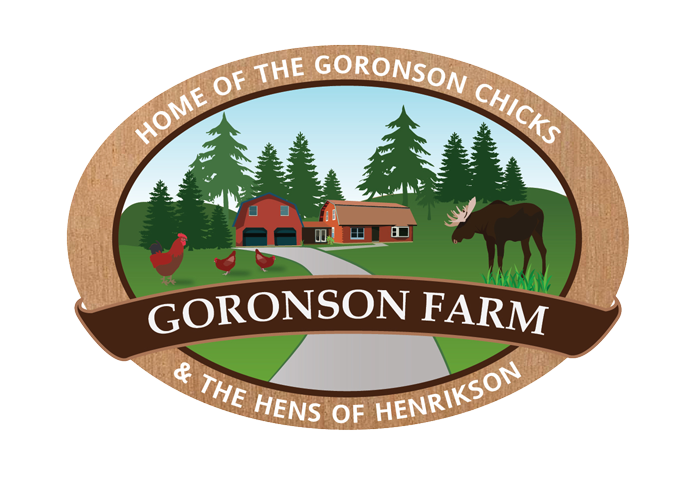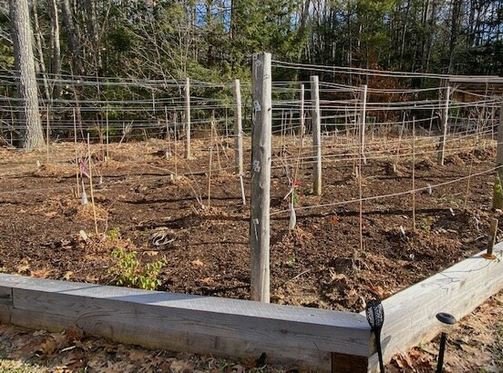The process of turning our 2023 grape harvest into wine. This was our first large grape harvest.
Grapes & Our Wine-making Journey
There are three vineyard locations around the farm home to almost 70 grape vines. The “Big Vineyard” where the majority of wine-grape vines reside is in the front yard to the left of the flower shop. The “small vineyard” where a mix of wine, but mostly dessert grapes grow is in the backyard to the right of the potato field, and the smallest wine grape vineyard with three vines is behind the new High Tunnel construction area. Growing grapes is a labor of love, careful cultivation, and patience. They need consistent, yearly pruning, and care. Grapes must be cut off for at least three years (some 5-6 years) to build good wood before actually harvesting the fruit. The majority of our vines are on their fifth growing year now - the past two years have been the first time we have been able to harvest grapes and that classic, full grape-bunch shape of first appeared in 2024.
Here are some of the grape varieties we are growing, plus tasting notes we have collected over the years…
Canadice
This is a delicious slipskin variety with a tender and edible skin. This grape has a distinct, but not overpowering, labrusca flavor. They are medium in size, produce 35-40 grapes per cluster, are pink to light red in color, and they are seedless.
Summer - Muscat
These are considered by most Europeans to be the most flavorful and aromatically delicious of all grapes. They are commonly used in the making of sparkling wines (Champagne). This yellow grape is so enriched with sugars that it is commonly grown for drying on the vines and making raisins.Red Flame (Seedless)
These grapes have colors that range from a brilliant flame red to a deep purple. They are excellent for fresh eating or making raisins.Crimson (Seedless)
A reliably sweet choice with a good crisp texture. They are the latest ripening seedless table grape, ripening in mid-October and, weather permitting, can be held on the vine through mid-November. These grapes range from a distinct red to a gorgeous ,dark purple.Summer Royal (Seedless)
Summer Royal is a juicy and delicious grape that holds a strong Muscat flavor. It is sweet, large, and firm to the touch. They are ideal as a dessert, table grape with an excellent taste.Concord
This is one grape that everyone knows and loves - an American favorite. Concords were described as “the grape for the millions” by Horace Greeley. The vines are vigorous, hardy, and productive and produce medium-sized clusters bearing large, blue-black berries. They are tough-skinned, flavorful, and highly aromatic.
Grapes
Cayuga White *
These are a very popular white hybrid grape variety; probably one of the most popular variety developed by the Geneva Wine Grape Breeding Program at Cornell University, New York.
Brianna
This beautiful grape variety produces light, semi-sweet table wines with grapefruit, tropical, and floral characteristics, with a pronounced pineapple notes when fully ripe.Chelois
These grapes are bred from two varieties of grapes, namely Roi de Noirs and Bienvenu. Both of these varieties are Siebel cultivars. Due to this fact, Chelois grape is also known as Seibel 10878 in some areas. It is used in the making of Chancellor, Baco Noir, and Chambourein. Chelois is an important variety, though the vines are tough to maintain and preserve.Corot Noir
This grape variety is a result of a cross made between Seyve VIllard 18-307 and Steuben in 1970. The wine has a deep red color, cherry and berry fruit aromas, and a soft, full tannin structure.Noiret *
This grape produces an excellent full-bodied, richly colored wine. The wines can resemble Shiraz (Syrah) with a distinct black pepper character, moderate tannins, and notes of raspberry, blackberry and mint.
Marquette*
This grape is rapidly becoming the most popular northern red grape variety. Typically maturing with high sugar content and moderate acidity, Marquette produces complex wines with attractive ruby colors and pronounced tannins, often with notes of cherry, berry, black pepper, and spice.
From humble beginnings in 2019 (pictured to the left)
To a full-grown vineyard (pictured to the right & protected with netting so birds and insects won’t be tempted to snack on the wine grapes)
Wine-making
After getting my Wine-Makers Certificate from Cornell, it was time to start one of the most ambitious undertakings: expanding the vineyard project to become an operational winery. Our current wine-making workspace is the Flower Shop. If you visit, you will likely see glass carboys full of fermenting wine dotted around the space, each at a different stage of becoming a delicious wine. We started our first batch of experimental wines in December 2022 - two red (Marquette & Noiret) and a white (Cayuga White). Just like growing our vineyard, wine-making has been a process of learning, trial and error, patience, and a buzzing excitement once a wine finally comes to fruition!
The process of turning grapes into wine starts with pressing the juice out of the fruit. Though this may have traditionally been done by stepping on the grapes, we have opted to use an antique cider press. After collecting the juice, we take the initial “specific gravity” which will later be used to determine alcohol levels once the wine is finished fermenting. We pour in some bloomed champagne yeast & any other additions (ex: juniper, elderberries, or oak chips), pop on an airlock, and the wine is on its way to a first ferment!
It can be quite a long wait to see grape juice become a tasteable wine. We have had two official wine tastings with our 2022 experimental Cayuga White, Marquette, and Noiret wines - a private tasting with the crew from Solo Italiano restaurant and a public sampling during our Maine Farmland Trust tour in 2023 . Each have gone better than we could have expected and gave us great feedback to be able to incorporate into future batches!
Jesse from Solo Italiano said of our Noiret, “Imagine that you are sitting in a castle in Scotland on a dark, foggy night. A fire is going in your room and you are reading while chestnuts roast. This is the wine in your hand”. This inspired the name we gave to this experimental batch: “Imagine Wines” . We hope that in future tasting, we can gather more imaginative musings.
This unique region of Maine where grapes are grown, the story of the vineyard and history of the farm, and the sometimes wild and whimsical atmosphere we have cultivated are all woven into the wines. As someone tastes the wine, we hope they taste the journey the grapes have gone on, and all the possibilities this new endeavor is ripe with!
Cayuga White (above) - our most prolific white wine grape with over 16 lbs harvested from one vine in 2024! In 2022, we started an experimental wine batch of Cayuga White. The flavor and scent profile was intriguing with hints of tropical grapefruit that became a gently fruity taste as the wine aged. That batch is going on two years old and every tasting we’ve had with it gets better and better.
This is just the beginning of the process. The juice will ferment for a period of time then be transferred into a secondary vessel for its first “racking”. This racking process may be repeated 2-4 times over a handful of months until the wine has reached the desired clarity and taste profile. This can take over a year! From there, the wine is ready for bottling where it is ready to drink, or can be aged further to continue deepening the wine’s profile.
Maine Farmland Trust Tour
Wine Tasting - July 2023












